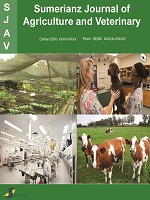Sumerianz Journal of Agriculture and Veterinary

Online ISSN: 2617-3077
Print ISSN: 2617-3131
Quarterly Published (4 Issues Per Year)
Journal Website: https://www.sumerianz.com/?ic=journal-home&journal=30Archive
Volume 6 Issue 2 (2023)
Study On Activation Energy, Moisture Diffusivity Effectiveness and Mathematical Modelling of Thin Layer Drying Kinetics of Red Pepper (Capsicum Annum L.)
Authors : Egbe Ebiyeritei Wisdom
DOI : doi.org/10.47752/sjav.62.19.25
Abstract:The thin-layer drying behavior of red pepper sample was examined using seven mathematical models that were found in the literature. According to the R2, RMSE, and v2 values with respect to the experimental and predicted moisture ratios the models were contrasted. The drying process happened throughout the period of falling rates. The findings demonstrated that the most acceptable model is the Midilli model for describing the drying behavior of thin layer pepper samples. The effective moisture diffusivity and moisture content were shown to be correlated by a third order polynomial relationship. As the moisture content of the pepper samples decreased the moisture diffusivity effectiveness increased, with an energy activation of 40.54 KJ/mol, the average effective diffusivity over the temperature range investigated was between 4.7 x 10-9 to 13.3 x 10-9 m2/sec.
Therapeutic Effects of Zea Mays Husk Extracts on the Behavioural and Haematological Alterations of Pseudomonas Aeruginosa sInfected Clarias Gariepinus
Authors : Abu O. M. G. ; Ukwe I. O. K. ; Audu S.
DOI : doi.org/10.47752/sjav.62.11.18
Abstract:The present study examined the behavioural and haematological alterations in Clarias gariepinus infected with Pseudomonas aeruginosa and exposed to Zea mays husk aqueous extract. One twenty (120) fish were infected via intra-peritoneal injection with 1.0ml of 1.5×105 cfu/ml of P. aeruginosa. After the infection the infected fish were distributed into four (4) different groups in triplicate. The four groups were treated with Zea mays husk aqueous extract via immersion in four different concentrations (treatments): 0ml/l (untreated), 10ml/l, 20ml/l, 30ml/l for a period of 9 days and water exchange was done every two days (48 hours). After infection behavioural changes such as poor swimming, air gasping, restlessness, serious wounds, discolouration of fins, loss of reflex, and loss of appetite were observed manually in the experimental fish at day 3, 6 and 9. Blood was extracted after day 3, 6 and 9 of treatment and taken to the laboratory for haematological analysis and results were compared to the control to ascertain the therapeutic effect of Zea mays husk aqueous extracts. Haematological parameters such as Pack Cell Volume (PCV), Hemoglobin (HB), Red Blood Cell (RBC), White Blood Cell (WBC), Platelets (PLT), Mean Corpuscular Hemoglobin (MCH), Mean Corpuscular Hemoglobin Concentration (MCHC) and Mean Corpuscular Volume (MCV) were determined in the experimental fish after day 3, 6 and 9 of treatment. Behavioural changes were more noticeable in the untreated (control) when compared to fish exposed to the various concentration of the aqueous extracts of Zea mays husk. The values of PCV, Hb and RBC decrease after infection, but there were restoration at various level of treatment. WBC and Platelets increases after infection but normalized as the period of treatment goes on MCV, MCH and MCHC decreases after infection and improve in the various treatment as the period of treatment increases. The present study has shown that Zea mays husk aqueous extracts have the capacity of normalizing alterations in the haematological parameters of P. aeruginosa infected Clarias gariepinus.


